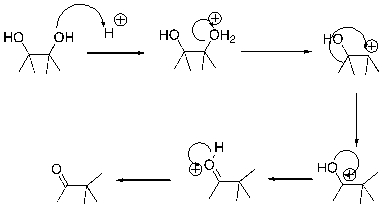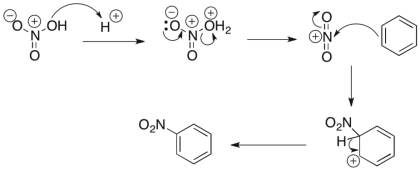A) Proton transfer
B) Loss of leaving group
C) Nucleophilic attack
D) Rearrangement
Correct Answer

verified
Correct Answer
verified
Multiple Choice
Which of the following mechanistic steps represents the loss of a leaving group?
A) ![]()
B) ![]()
C) ![]()
D) ![]()
Correct Answer

verified
Correct Answer
verified
Short Answer
Estimate the enthalpy change of the following reaction under standard conditions. 
Correct Answer

verified
Correct Answer
verified
Short Answer
Does a reaction with a H of 20 kJ/mol and a S of 10 J/mol K at 298 K favor reactants or products?
Correct Answer

verified
Correct Answer
verified
Multiple Choice
What type of bond cleavage does the following reaction involve? 
A) homolytic
B) heterolytic
Correct Answer

verified
Correct Answer
verified
Multiple Choice
Predict the sign of G for an endothermic reaction with a decrease in entropy.
A) positive
B) negative
C) no change
D) cannot predict without additional information
Correct Answer

verified
Correct Answer
verified
Multiple Choice
What pattern of curved arrow pushing is the second step of this reaction? 
A) Proton transfer
B) Loss of leaving group
C) Nucleophilic attack
D) Rearrangement
Correct Answer

verified
Correct Answer
verified
Multiple Choice
Which of the following is an energy diagram for a two-step reaction?
A) ![]()
B) ![]()
C) ![]()
D) ![]()
Correct Answer

verified
Correct Answer
verified
Essay
Identify the electrophilic site in the following molecule. 
Correct Answer

verified
Correct Answer
verified
Multiple Choice
Which of the following is the most likely structure of the following cation after rearrangement?

A) ![]()
B) ![]()
C) ![]()
D) ![]()
Correct Answer

verified
Correct Answer
verified
Multiple Choice
Later in the course, we will compare the halogenation of differently substituted carbons, comparing reactions like the ones below. Which of the following statements is true about reactions A and B? 
A) Both reactions have a positive heat of reaction ( Ho)
B) Neither reaction has a positive heat of reaction ( Ho)
C) Only reaction A has a positive heat of reaction ( Ho)
D) Only reaction B has a positive heat of reaction ( Ho)
Correct Answer

verified
Correct Answer
verified
Multiple Choice
What pattern of curved arrow pushing is the second step of this reaction? 
A) Proton transfer
B) Loss of leaving group
C) Nucleophilic attack
D) Rearrangement
Correct Answer

verified
Correct Answer
verified
Short Answer
Will the following cation undergo rearrangement? 
Correct Answer

verified
Correct Answer
verified
Multiple Choice
Identify the nucleophilic atom in the following molecule. 
A) P
B) C
C) H
D) Me
Correct Answer

verified
Correct Answer
verified
Multiple Choice
What pattern of curved arrow pushing is the second step of this reaction? 
A) Proton transfer
B) Loss of leaving group
C) Nucleophilic attack
D) Rearrangement
Correct Answer

verified
Correct Answer
verified
Essay
Identify the nucleophilic site(s) in the following molecule. 
Correct Answer

verified
Correct Answer
verified
Multiple Choice
Which of the following is the enthalpy change of the following reaction under standard conditions? 
A) -8 kJ/mol
B) +8 kJ/mol
C) +222 kJ/mol
D) +79 kJ/mol
Correct Answer

verified
Correct Answer
verified
Multiple Choice
Predict the sign of S of the following reaction. 
A) positive
B) negative
C) no change
Correct Answer

verified
Correct Answer
verified
Essay
The following reaction has three mechanistic steps. Identify the pattern of arrow pushing steps in each step. 
Correct Answer

verified
Proton transfer; los...View Answer
Show Answer
Correct Answer
verified
View Answer
Short Answer
Does a reaction with a positive G favor reactants or products?
Correct Answer

verified
Correct Answer
verified
Showing 21 - 40 of 110
Related Exams